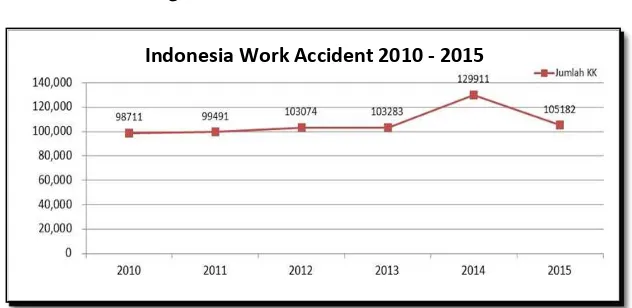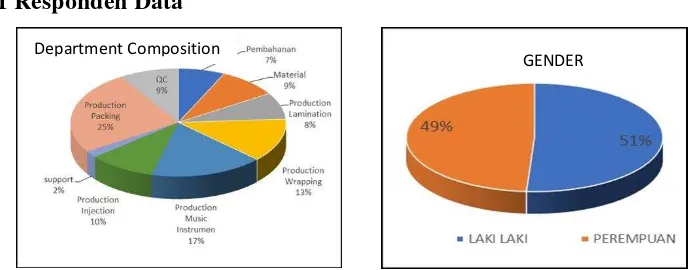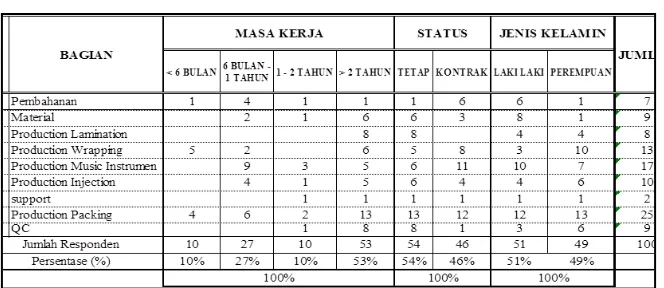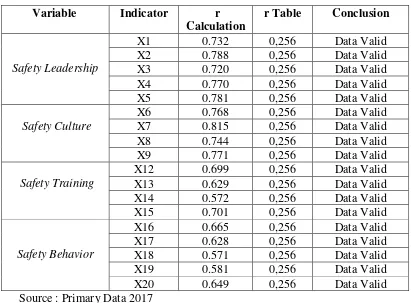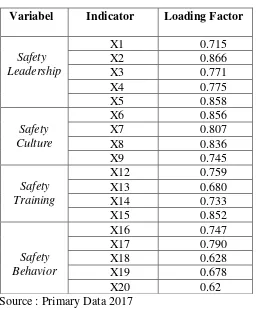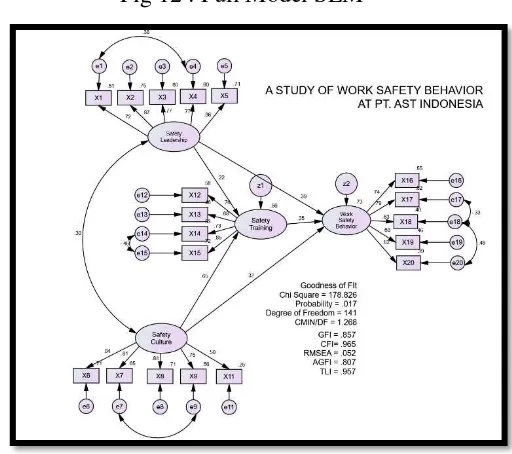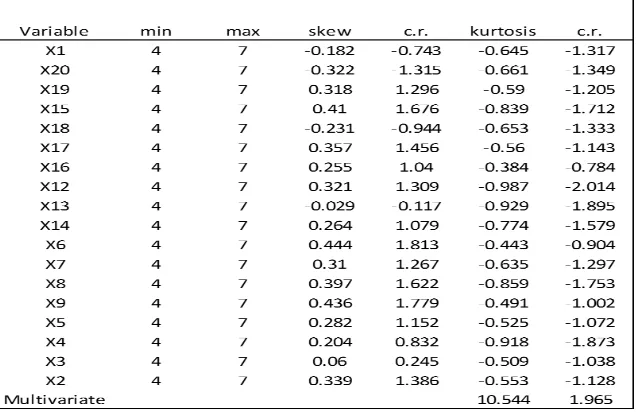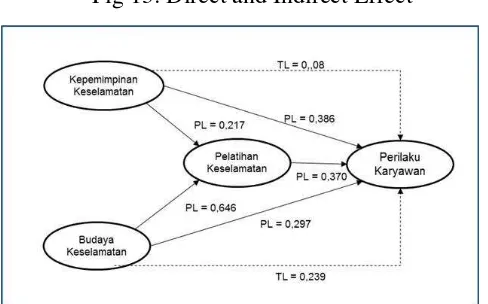1
A STUDY OF WORK SAFETY BEHAVIOR
AT PT. AST INDONESIA SEMARANG
Ari Heryanto,
Fuad Mas’ud, Edy Rahardja
Magister Management Department Economic and Business Faculty Diponegoro University, Semarang
ABSTRACT
The aim of this study is to analyse the effect of Safety Leadership, Safety Culture and Safety Training that influences the employee Safety Behavior at PT. AST Indonesia Semarang.
Mixed methods with sequential explanatory type approach was utilized in this study. The quantitative instruments were using SEM methods while Indonesian and Japanese manager interview was used for the qualitative instrument.
The study involved 100 employees as the questionnaire respondents from 600 production employees population and 3 manager as intervieweer. Simple random sampling was use at quantitative research with a proportional quantity of responden have taken in every department depend on total employee in each department. The validation of qualitative result have used by honest validation from respondens which was confirmated and approved by responden’s with their signature at qualitative question and answer list.
Based on the result of the quantitative and qualitative data, the research hypothesis conclusion for Safety Leadership, Safety Culture and Safety Training effect is positive and significant to Safety Behavior and the other findings at this research could be explained that the direct effect of Safety Culture to Safety Training (0.646) more than Safety Leadership effect to Safety Training (0.217). In other side Safety Leadership effect to Safety Behavior (0.386) more than Safety Culture effect to Safety Behavior (0.297). The indirect effect between Safety Leadership (0.08) and Safety Culture (0.239) to Safety Behavior was lower than the direct effect, this result shown that Safety Training is not an intervining variable on this research.
2 1. INTRODUCTION
Work safety is to be an aspect as a main issue for all of the business sector in all over working area beside quality and productivity. Gary Wong (2012) said at his
article “Making Sense of Safety Culture a Complexity Based Approach 2012”, he was explain a new transformation for safety thinking.
Gary Wong explain that the transformation for safety thinking, as follows since 1930-1960, safety thinking was based on what goes wrong about the work, at least 1960-2012 safety thinking was based on “Theory of Error” or based on the analysis of accident and system failed and to avoid the non compliance of the safety role. Since up to now, safety thinking base on “Theory of Action”. The action is to prevent the safety problem or accident with respecting the information and first attention of safety and daily productive work.
Rob Long (2015, p1) said safety have to be more than an activity and as a
worldview or today’s philosopy. They indoctrinated or enculturated suitable with safety worldview. All of this will be a paradigm for all of thing that have a safety first motto.
Human survival sense have given by Allah, for this reason, human start to make a life with looking for physical demand such as food, drink and life safety protection. In a new era physical demand could be support with findings the job to get the salary, and human can buy the food or something else to support their life, but in fact the job sometimes is unsecure or unsafe that will give an accident to human. Safety thinking at work place starting to protect and restrict the accident.
The Indonesian rule UU no 7, 1970 chapter V-9 have the safety arrangement for zero accident purpose but in fact the accident case is more than 90.000 case in year 2010-2014. This result shown that safety management is not enough to protect the safety. The company need to build other variable to make a good safety performance such as Safety Leadership, Safety Attitude, Safety Training and Safety Culture.
1.1Statement of The Problem
3 Fig 1 : BPJS Accident Data
Source : Huda et al (2016)
Fig 2 : PT. ASTI fatal accident data
Source : PT. ASTI Safety & Enviroment data (2016)
Fig 2 have shown the problem of PT. ASTI Safety performance was appears since 2016, fatal accident increased to 6 case.
1.2Research Objectives
The objectives of the research are as follows:
1. To investigate the effect of Safety Leadership, Safety Culture, Safety Training positively influences on the Safety Behavior at PT. ASTI.
2. To Investigate the perception of Indonesian and Japanese manager about the effect of Safety Leadership, Safety Culture, Safety Training on the Safety Behavior at PT. ASTI.
1.3 Research Question
FATAL
C
ASE
4 Based on research gap, the research question could be declare as follows :
1. How the effect of Safety Leadership to the Safety Training 2. How the effect of Safety Culture to the Safety Training 3. How the effect of Safety Training to the Safety Behaviour 4. How the effect of Safety Leadership to the Safety Behaviour 5. How the effect of Safety Culture to the Safety Behaviour
6. What of the manager’s perception about Safety Leadership, Safety Culture,
Safety Training for the employee’s Safety Behavior
1.4 Research Hypotesis
In view of the above research question point 1 to point 5, the following null hypothesis were formulated:
1. H1, The Safety Leadership is positive and significat influence to the Safety Training
2. H2, The Safety Culture is positive and significant influence to the Safety Training
3. H3, The Safety Training is positive and significant influence to the Safety Behaviour
4. H4, The Safety Leadership is positive and significant influence to the Safety Behaviour
5. H5, The Safety Culture is positive and significant to the Safety Behaviour
2. LITERATURE REVIEW
2.1Safety Leadership
Safety professionals are charged with reducing employee injuries and promoting a strong Safety Culture within their organizations. To achieve this, they must gather and apply information from many sources, including psychology. In fact, much information has been gleaned from one of the most powerful and proven subdisciplines in psychology, applied behavior analysis.
Astuti (2010) said the professional experiences have been running the best practices to implemented world Safety Culture, she said that Safety Culture development starting from top management and the organization’s management team.
5 Healay & Derbyshire (2012) said transformational and transactional leadership have empiricely supported and conformited with the effective safety management. Effective Safety Leadership doing coach with safety oriented, supported and provide resources that needed and push the employee participation in safety. Manager leadership style and behavior not only direct effect to safety but also indirect effect mechanism that will grows positive safety climate perception and then effect to the safety performance. Safety communication dan employee participation to increase safety performance must build with a good relation between management and employee, ordinary supervisor and employee will believe that management respons and respect safety information can effected by bottom up communication. Managerial leadership training intervention could make a positive effect to safety and to be an effective way for manager to develop their Safety Leadership ability.
2.2Safety Culture
Freimuth (2006) said, Safety Culture firstlty come from nuclear industry. The fatal accident was happen at three mile island nuclear factory at electric power plant. The investigation from nuclear supervisory body and finding the basic reason why the accident was happen.
After Chernobyl fatal accident, International Agency for Energy Atom (IAEA) have identified the good Safety Culture as main contributor for accident cause. IAEA report that the accident related with safety base on Safety Culture perception. Culture as a concept to managerial combined, organizational and social factor (Clarke 2000).
Crossman (2008), The Safety Culture promotion has been a best practiced for manage the risk, created the culture inside the organization where the peoples as a personal contribute to make sure the safety in which clear safety value.
Peters & Waterman in Hofstede (2005) declare that culture have related strongtly and main factor for organization succeed.
2.3Safety Training
Ribson LS et al (2012) said training is an important component in safety and health programme at least 15% population have been trained by OHS every year. Training effectiveness now still developing.
6 month. Clarke and Flicroft also recommend that safety training intervention must suitable with company training needed. Those intervention must involve inside the process and company procedure and safety training must be a part of company strategy and consistent with their business.
Kustono (2003) said work safety training have significant effect for increasing safety attitude. Burke at al (2010) in his research findings that safety training dan safety culture impact the knowledge for safety and health. For the safety knowledge, training is more interested and more effective than without training. This implication is testing theory and information combining for work safety risk.
2.4Safety Behavior
Hsu et al (2008), declare safety behavior is the employee always compliance the safety rule. Employee could be safe action or not while they do the job. Safety behavior in work floor in important to minimize the safety problem.
Martinez et all (2011), in their research show tha safety behavior is an exact approaching to reduce the accident. There is two dimention for Safety Behavior, Safety Compliance and Safety Participation.
IOSH (Institution of Occupational Safety and Health Direction 06.1), Safety Behaviour is a part of safety management as a prespective approach across safety engineering or procedure. IOSH also said that the accident basically built from many near miss and unsafe act, such like triangle figure 3. Below,
Fig 3 : Safety Triangle (IOSH Direction 06.1)
7
3. RESEARCH METHODS
Mixed methods with sequential explanatory type approach was utilized in this study. The quantitative instruments were using SEM methods while Indonesian and Japanese manager interview was used for the qualitative instrument. The study have involved by 100 employees as the questionnaire respondents from 600 production employees population and 4 manager as interviewees.
The questionnaire was designed to obtain the representation of the opinion of 100 person using likert scale. The scale choiced in 1-7 point. The questionnaire was also designed to obtain 20 indictors.
The qualitative interview list was designed to obtain perception of Japanese and Indonesian manager about Safety leadership, Safety Culture, Safety Training and Employee Safety Behaviour.
Simple random sampling was use at quantitative research with a proportional quantity of responden have taken in every department depend on total employee in each department. The validation of qualitative result have used by honest validation from respondens which was confirmated and approved by responden’s with their signature at qualitative question and answer list.
The final result will compare between the quantitative hypothesis result and qualitative result.
4. RESULT AND DISCUSSIONS
4.1Responden Data
Department Composition
GENDER
Man Woman
8 Fig 4 explain the composition of responden come from while fig 5 explain the gender of responden such as 49% woman and 51% man.
Fig 6 : Responden Experience Fig 7 : Responden Status
Fig 6 explain the experience of responden as follow, 53% have 2 year experience, 27% have 6 month to 1 year experience, 10% have 1-2 year experience, 10% below 6 month experience, while fig 7 explain 54% permanent working status of responden and 46% contract working status.
Table 1 : Responden Data
Source : Primary Data 2017
4.2Reliability and Validity Test
Using SPSS version 16, data validity can be find at correlated item total correlation or product moment ( r ) compare to r tabel at probability 0.01 (0.256). If product moment ( r ) ≥ r table than the question on questionnaire is valid and next step can continue with reliability test. The data validity shown at table 2.
Responden Status Responden Experience
53 %> 2 year, 27 % 6 month – 1 year, 10 %
9 Table 2 : Validity Test Summary
Variable Indicator r
Source : Primary Data 2017
The reliability can be test with comparing cronbach alpha wit cut off value (0.7) if the cronbach alpha more than cut off value then questionnaire is reliabel. Reliability test shown in table 3.
Table 3 : Reliability Test Summary
Variable Cronbach Alpha Cut Off Value Conclusion
Safety Leadership 0.903 0.700 Reliabel
Safety Culture 0.898 0.700 Reliabel
Safety Training 0.825 0.700 Reliabel
Safety Behavior 0.824 0.700 Reliabel
10 4.3Construct Validity
Requirement value of convergent validity is loading factor same or more then 0.5. Loading factor data shown at table 4.
Table 4 : Loading Factor
Variabel Indicator Loading Factor
Safety
The test result show that all of loading factor in each indicator suitable with the
criteria (≥0.5), this model have accepted.
4.4Construct Reliability and Variance Extracted
11 Table 5 : Construct Reliability and Variance Extracted
Source : Primary data 2017
4.5Confirmatory Factor Analysis (CFA)
Confirmatory Factor Analysis will use for SEM method to ensure the indicator is exactly build the laten variable (Haryono, 2017). This research was use CFA first order before build the full model. CFA first order of each variable can show as follow :
Fig 8 : CFA Safety Leadership Fig 9 : CFA Safety Culture
12
Fig 10 : CFA Safety Training Fig 11 : CFA Safety Behavior
Fig 8 explain that CFA Safety Leadership is suitable with Goodness of Fit (see table 6), fig 9 explain CFA Safety Culture also suitable with Goodness of Fit (see table 6), fig 10 explain CFA Safety Training on e14 and e15 as AMOS 22 modification indices output must related with covarian to make a suitable result with cut off value. The same condition in fig 11 CFA Safety Behavior need give covarian between e17-e18 and e18-e20. After modification indices, all Goodnees of Fit requirement have been suitable.
All of the CFA above was suitable with Goodness of Fit Index below :
Table 6 : Goodness of Fit CFA
Source : Primary data 2017
The conclusion of all CFA first order for all construct could be used to build a full model.
Goodness of Fit Index
Cut-off Value
Safety Leadership
Safety Culture
Safety Training
Safety Behavior
Chi-Square
<df, α =
0,05 1,910 7,802 0,388 1,315
Probability ≥ 0,05 0,752 0,215 0,533 0,725
GFI ≥ 0,90 0,993 0,972 0,998 0,995
AGFI ≥ 0,90 0,972 0,915 0,980 0,974
CFI ≥ 0,95 1,000 0,992 1,000 1,000
TLI ≥ 0,90 1,018 0,984 1,026 1,031
13 4.6Full Model Structural Equation Model (SEM)
Full model for this research can explain in fig 12. The model have build by the construct such as Safety Leadership, Safety Culture, Safety Training, Safety Behavior. On Safety Culture construct, indicator X10 have dropped out because it Cronbach alpha is higher than the construct’s Cronbach alpha.
Fig 12 : Full Model SEM
Source : Primary data 2017
The Goodness of Fit criteria and Goodnes of Fit model can explain in table 7,
Tabel 7 : Goodness of Fit Full Model
Source : Primary data 2017
Goodness of Fit Cut-off Value Result Remark
Chi-Square <df, α = 0,05 148,287 Good
Probability ≥ 0,05 0,060 Good
GFI ≥ 0,90 0,871 Marginal
AGFI ≥ 0,90 0,820 Marginal
CFI ≥ 0,95 0,976 Good
TLI ≥ 0,90 0,970 Good
14 4.7Normality of Data
Observed variable estimated using maximum likelihood must suitable with multivariate requirement. Amos 22 output have calculating multivariate below:
Tabel 8 : Research Normality Data
Source : Primary Data 2017
Above table explain the result of multivariate, containing CR value was outside of range of + 2.58.
4.8Quantitative Result
The hypothesis test on this research will use t-value with probability level 0.05.
t-value in AMOS 22 output is same with Critical Ratio on Regression Weight. The criteria to accepted the H1 was CR value ≥1.967 or probability (P) ≤0.05
(AMOS show with ***), then H0 was rejected. The result as follow:
Tabel 9 : Regression Weights (Group number 1-Default model)
15 The hypothesis conclusion :
1. H0 reject and H1 accepted, H1 : The Safety Leadership is positive and significant influence to the Safety Training
2. H0 reject and H1 accepted, H2 : The Safety Culture is positive and significant influence to the Safety Training
3. H0 reject and H1 accepted, H3 : The Safety Training is positive and significant influence to the Safety Behavior
4. H0 reject and H1 accepted, H4 : The Safety Leadership is positive and significant influence to the Safety Behavior
5. H0 reject and H1 accepted, H5 : The Safety Culture is positive and significant to the Safety Behavior
Research also findings the direct effect of Safety Culture to Safety Training (0.646) more than Safety Leadership effect to Safety Training (0.217). In other side Safety Leadership effect to Safety Behavior (0.386) more than Safety Culture effect to Safety Behavior (0.297). The Indirect effect between Safety Leadership (0.08) and Safety Culture (0.239) to Safety Behavior was lower than the direct effect, this result shown that Safety Training is not an intervining variable on this research. Figure 13 show the effect,
Fig 13: Direct and Indirect Effect
Source: Primary data 2017
4.9Qualitative Result
The quantitative interview was held for 2 Indonesian Manager and 1 Japanese Top manager. There is 6 questions for Safety Leadership, 5 question for Safety Culture, 2 question for Safety Training, and 6 question for Safety Behavior. The result of the qualitative research will compare to the quantitative research.
16 The conclusion for this research can find in the comparison table below :
Tabel 10 : Comparison Between Quantitative and Qualitative Result
Safety
The evidence show that PT. AST have created safety procedure including Safety Training procedure
Strengthen
Safety Culture in PT. ASTI have
supported to Safety Training Strengthen The Employee’s experience have
enough to know the risk after join in Safety Training
Strengthen
Safety Culture is a priority after PT. ASTI Management declare the safety target to the
Department, including target of Safety Training member
Strengthen
Safety Culture in PT ASTI could be shown from the employee’s participating on KYT and RA
Strengthen
Safety Training and
The Safety Training is
Safety Training have given by company for safety risk potential awareness importance of Safety in many media such as healty talk, safety talk and exemplary
Strengthen
Manager have give their
exemplary with use the PPE same
as employee’s PPE Strengthen
There is a safety priority concept
before decided the policy Strengthen Manager have give their trust to
the employee to implement safety procedure
Strengthen
The company and manager have support the employee to join in safety training
17
Protecting the safety equipment and safety opinion is an evidence that employee could work safely beside participate in Risk
PT. ASTI still need a tight
supervising to the employee when implementing safety procedure
Strengthen
The employee start to find the
potential risk at work place area Strengthen The employee’s participation still
less for safety opinion Weaken The employee have safety priority
eventough need more
confirmation at higher population
Weaken
The employee have active to keep
in clean, work safety and health Strengthen Source : Primary data 2017
5.1Policy Implication
5.1.1 Company
The research result shown that there is a positive relation between Safety Leadership, Safety Culture, Safety Training to the Safety Behavior, reminding the fatal accident still appears, the company is better to do below:
1. Periodically must held measurement survey for employee safety behavior to ensure the safety compliance and safety participation to prevent the risk with considering employee turn over. The survey result will follow up with anticipated policy and safety training modification to increase quality of training.
2. Periodically must held managerial survey to all of manager that will create the policy. The measurement factor is Safety Leadership that contain indicator such as Safety Promotion, Safety Teaching, Safety Coaching, Safety Delegating, Safety Motivation. The survey result will follow up with company policy to increase Safety Leadership. For example company held safety leadership training.
18 5.2.2 Professional / Manager
Professional or manager need to learn safety leadership because they will be a role model to the employee primarily in safety Behavior.
REFERENCES
Astuti, Nurwidi, 2010, “Peran safety leadership dalam membangun budaya keselamatan yang kuat”, seminar nasional vi sdm teknologi nuklir yogyakarta, ISSN 1978-0176
Bernard B, 2014, Safety Culture as a Way of Responsive regulation : proposal for a Nuclear Safety culture Oversight Model, International Nuclear Safety Journal, Vol.3 issue 2, pp.1-11
Conchie Stacey and Moon Susannah, 2010, Promoting Active Safety Leadership, IOSH Research Committee report 10.2, University of Liverpool
Creswell, John W. 2006. Research Design Pendekatan Kualitatif, Kuantitatif, dan Mixed. Yogyakarta , Pustaka Pelajar
Dyer W Wayne, 2014, Perception of Safety Safety Culture.http://dx.doi.org Chap 1.
Dorfman et.al,1997,”Leadership in Western and Asian countries Commonalities and
Differences in Effective Leadership Process Accros Cultures” leadership quarterly vol. 8 no. 3 1997, p233
Dunlap E Scott, 2011 “ Safety Leader”. Professional Development Peer-Reviewed, edition September, p42-49
Ferdinand, Augusty. 2006. Metode Penelitian Manajemen : Pedoman Penelitian untuk skripsi, Tesis dan Disertai Ilmu Manajemen. Semarang Universitas Diponegoro
Ghozali, Imam, 2006, Aplikasi Analisis Multivariate dengan Program SPSS. Edisi Keempat. Semarang, Badan Penerbit Universitas Diponegoro
19 Nazaruk Marcin, 2011, Developing Safety Culture Interventions in the Manufacturing Sector, thesis submitted for the degree of Doctor of Philosophy Department of Psychology University of Bath.
Mas’ud, Fuad 2004, Survai Diagnosis Organisasional Konsep dan Aplikasi, Badan Semarang, Penerbit Universitas Diponegoro
Mullen E Jane, Kelloway E Kevin 2009, Safety Leadership : A longitudinal effect of transformational leadership on safety outcomes, Journal of Occupational and Organizational Psychology (2009), 82, 253-272 The British Psychological Society
Roughton E James and James J. Mercurio, Developing an Effective Safety Culture: A Leadership Approach, Library of Congress Cataloging-in-Publication Data, ISBN 0-7506-7411-3, USA
Sugiyono 2013, Metode Penelitian Manajemen, Bandung. Penerbit Alfabeta
S.H. 650 Hsu et al, 2010, ”The influence of organizational factors on safety in Taiwanese high-risk industries”, Journal of Loss Prevention in the Process Industries. Journal of Loss Prevention in the Process Industries 23 (2010) 646e653
Williams H Joshua, 2001, Improving Safety Leadership Using industrial / organi zational psychology to enhance safety performance. AprilProfesional safety
